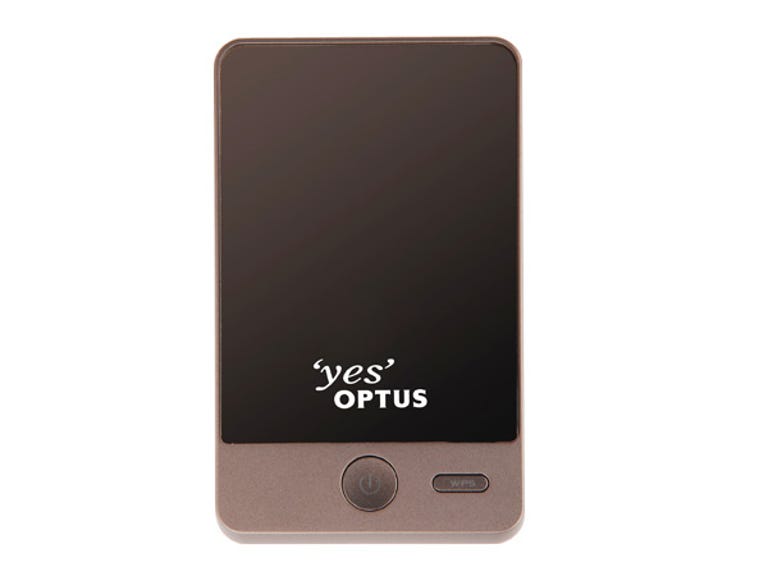 Why You Can Trust CNET
Why You Can Trust CNET Optus Mini WiFi Modem review: Optus Mini WiFi Modem
Optus' Mini WiFi has some impressively shiny hardware, but the carrier's charging regime remains a significant roadblock to our recommendation of it.
Design
The concept of a multifunction device is nothing new in the technology sector. We're more than bored with most multifunction printers, computers are multifunction by design, and although it wasn't that long ago that mobile phones only really did one thing, we couldn't go back to those days now. The Optus Mini WiFi Modem is perhaps the first try we've seen at a portable 3G modem-router that incorporates multiple functions, although not in a way you'd expect. The incredibly reflective surface of the modem also doubles as a compact mirror. So if you've been dying to check the status of your lippy while surfing the web, you now can.
The Good
The Bad
The Bottom Line
It's a curious decision on Optus' part to use the word "Mini" in relation to its 3G modem, as compared to models such as Telstra's Prepaid Mobile Broadband Hotspot, Vodafone's Pocket WiFi or Virgin's Mobile Broadband WiFi modem the Mini WiFi Modem simply isn't. At 96x57x11.5mm, it's the size of a small smartphone.
Features
Optus is still a service rather than a hardware company, and while it bears prominent Optus branding on the front, the rear of the Mini WiFi modem reveals its true hardware origins. It's a re-badged Huawei E583C with Optus-specific firmware, and more specifically, an HSPA-capable 802.11b/g router that works, not surprisingly for an Optus product, on the 900/2100MHz wavelengths. Up to five compatible devices can connect to the Mini WiFi at any one time. Huawei's page for the E583C suggests top speed range of up to 7.2Mbps for this particular model. Like many portable modem routers, it's also capable of acting as a storage device via microSD card. If you're working from a system that lacks Wi-Fi, it's also possible to use the Mini WiFi Modem as a tethered USB modem from the unit's mini-USB port.
Despite having such a large display screen, the one thing you won't see much of on the front of Mini WiFi Modem is connection detail. The OLED display takes up a tiny fraction of the front display, and once it's shown the Optus splash screen, you'll be given three small lines of information relating to the current connection.
Optus provides "up to" 8GB of data with a relatively generous six-month expiry, although there's a sting in the tail of that offer, which we'll cover shortly.
Performance
The Mini WiFi comes with security enabled out of the box via a password that's permanently printed on the back, inside the cover. Once you've set up the account (our review unit came with a pre-configured account), you could just fire it up and surf securely. The in-built web-based configuration utility isn't particularly hard to deal with if you want to tinker or set your own unique SSID and password.
The Mini WiFi is powered via a 1400mAh Lithium-ion battery. In our tests, we managed to keep the unit running and providing data to an iPad and a pair of mobile phones for four hours and 10 minutes, which is pretty impressive for a portable router. It's not quite a full day's work if you use it all at once, but if you're moving between other data sources, it could supplement them nicely. Likewise, Wi-Fi range was decent for such a small unit, and we found we could easily move between two rooms and maintain a decent connection.
Mobile broadband is, by definition, quite variable depending on location and service usage. In our tests in Sydney and Adelaide, we managed variable speeds from 1.67Mbps up to a maximum of 3.40Mbps using the Speedtest.net utility on an iPad connected to the Mini WiFi Modem.
There's only a single factor in the Mini WiFi's hardware that we're not that fond of, and that's the display screen. While it makes a nifty backup mirror, that same reflective surface and low brightness OLED screen is almost impossible to read in direct sunlight. If you need to check the status of the connection during daylight hours, it's a case of squinting, holding your hand over it to block the sun or just plain giving up.
The other major catch with the Optus Mini WiFi has nothing to do with the hardware at all, but more to do with Optus' current data provisioning rates. The Mini WiFi works on a prepaid basis, and at the time of writing, Optus' standard for data charging, irrespective of the recharge value on the modem is to charge in 10MB blocks. The first 30MB per day is only charged as 10MB, but still, if you used the device only intermittently, you'd burn through a lot more data than you might expect, even if your connection and actual data usage was quite low. What's truly odd here is that while Optus is charging data at 10 times the rate that Telstra or Vodafone do, if you use Virgin Mobile's broadband, it's charged at a per kilobit rate, a full one hundred times less than Optus does. The weird thing there is that Virgin Mobile's a fully owned subsidiary of Optus. There has to be a happy medium somewhere in there, but we're certainly not happy with the concept of being slugged 10MB per data per session.



